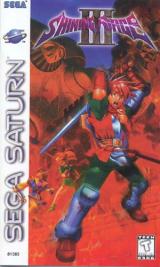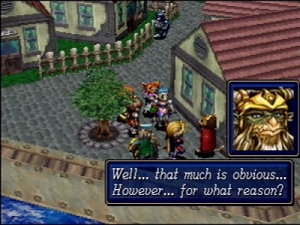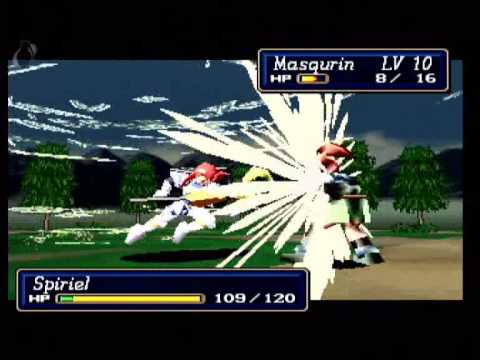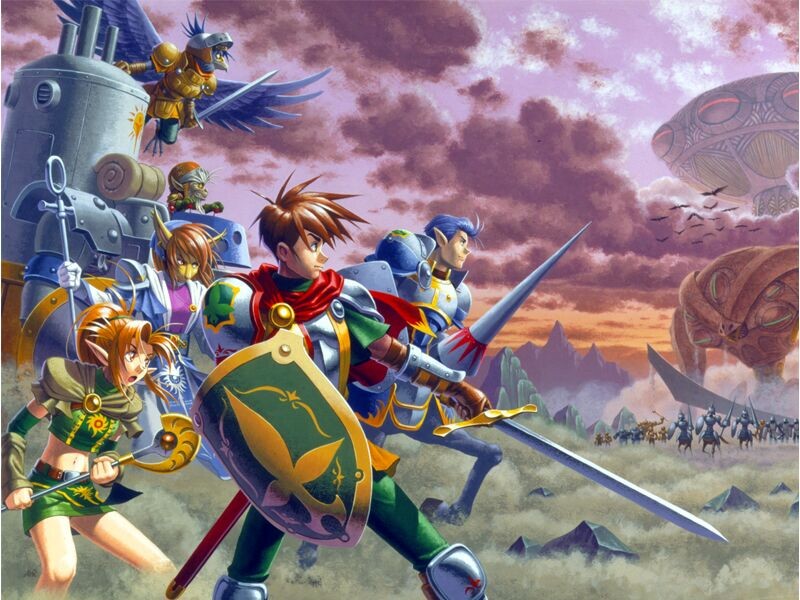 In 1998, Bernie Stolar’s infamous “The Saturn is not our future” speech signaled the premature demise of the Saturn just as both of its competitors were gearing up for record holiday seasons. Saturn fans had been long resigned to certain revered titles remaining Japan-only. This time, however, Sega threw the fanbase a few bones. Though they were too little, too late, these games provided a powerful finale to a struggling console. One of these games was Shining Force III, the 3-D sequel to a popular Genesis SRPG series produced by Camelot Software Planning (Mario Golf, Golden Sun).
In 1998, Bernie Stolar’s infamous “The Saturn is not our future” speech signaled the premature demise of the Saturn just as both of its competitors were gearing up for record holiday seasons. Saturn fans had been long resigned to certain revered titles remaining Japan-only. This time, however, Sega threw the fanbase a few bones. Though they were too little, too late, these games provided a powerful finale to a struggling console. One of these games was Shining Force III, the 3-D sequel to a popular Genesis SRPG series produced by Camelot Software Planning (Mario Golf, Golden Sun).
The Shining Force games were among the most highly-regarded games on the Genesis, and SFIII, much like the PS1 Final Fantasy games, did not differ wildly in game mechanics compared to its 16-bit siblings. Like Final Fantasy, SFIII used 32-bit technology for impressive cut scenes and spectacular 3-D battle animations. Though it lacked the graphical sophistication of the new generation of PS1 RPGs typified by Final Fantasy VIII, SFIII was still an impressive game that helped dispel the notion that the Saturn couldn’t do 3-D.
As with many SRPGs, the plot of Shining Force III is heavy in political intrigue. The main character, Synbios, is a soldier of the Republic of Aspia attending a peace summit between the Republic and the old Empire in the neutral city of Saraband. When the Republic’s emissary, Benetram, is framed for the kidnapping of the emperor by the Bulzome sect of masked monks, Synbios, Benetram, and their allies find themselves fleeing pursuit by an Empire determined to exact revenge upon them!
Shining Force III’s battle system is similar to other SRPGs you may have played. You acquire an army of various melee fighters, archers, mages, and healers, each with their own strengths and weaknesses with regards to navigating the terrain and attacking the enemies, and battles play out on grids where the allies and the enemies take turns advancing upon each other. It is important to monitor not just your own party’s actions, but those of the enemies as well. The balance of power between your party members and the enemies is very delicate, and rushing headlong into an enemy assault is a recipe for disaster. In many ways, Shining Force III’s SRPG mechanics are not quite as sophisticated as those of Final Fantasy Tactics, but they’re still very well done, and every battle will be a tense game of cat and mouse. Shining Force III, however, has much larger scale battles than FF Tactics. Where Tactics was limited to 5 player characters and five or six enemies, SFIII’s battles, can involve 20 or more units at a time. Enemies will actively call in reinforcements during battle instead of being stuck with a preset squadron through the duration.
 Unlike other SRPGs, Shining Force 3 actually lets you explore the game’s towns and wildernesses on foot, just like a regular RPG. In most SRPGs, towns are navigated entirely through menus offering basic shops and taverns. I appreciated the freedom to explore on my own, especially with more and more contemporary RPGs reverting to menus and point-and-click interfaces to interact with towns, and I wish more SRPGs (and RPGs in general) would do this.
Unlike other SRPGs, Shining Force 3 actually lets you explore the game’s towns and wildernesses on foot, just like a regular RPG. In most SRPGs, towns are navigated entirely through menus offering basic shops and taverns. I appreciated the freedom to explore on my own, especially with more and more contemporary RPGs reverting to menus and point-and-click interfaces to interact with towns, and I wish more SRPGs (and RPGs in general) would do this.
It is during confrontations between units that the game’s graphical engine comes into play, as you watch the attacks play out in 3-D sequences. The character models and spells take obvious cues from the PS1 Final Fantasy games, but they are not overly drawn-out, similar to Final Fantasy VII compared to the two later games, and they are stylish and spectacular, which was the fashion for 32-bit RPGs where the designers wanted to play with every graphical trick they had at their disposal.

The music is composed by Motoi Sakuraba, better known for his work for tri-Ace (Valkyrie Profile, Star Ocean) and Namco (the Tales series, where he got his start). The sound quality is more on par with Super NES games than PS1 titles, but the music is also catchy in the way that the better 16-bit soundtracks were, and certainly SFIII is a huge step up from the sound quality of the Genesis games. The game features brief voice clips for the characters during cut scenes, and the music is naturally much higher quality during cut-scenes as well.
The Shining Force III released in the US is actually only the first part of what was a 3-part game in Japan. Scenarios 2 and 3 were never localized in English. Supposedly, if you play through all three scenarios, you can combine the save date from all three games to unlock the saga’s “true” ending. While it’s disappointing that the other two scenarios are forever lost to Americans, except through importing, don’t let that deter you. Shining Force III is a full, rich experience as a standalone game.
Shining Force III is the best Saturn game I’ve played so far. It holds its own against the best PS1 RPGs, and is still one of the best SRPGs ever made. In one of the missions, where Synbios and his army must save a band of Republican refugees from pursuing Imperial troops at a railway switching point while maneuvering around moving trains, I can see some of the groundwork for later games like Valkyria Chronicles. This game is an essential part of any Saturn owner’s library, and I’m excited about the prospect of playing Scenarios 2 and 3 even if they are in Japanese.
SCARCITY: Shining Force III can readily be found on Amazon or eBay, but it isn’t cheap. A good copy with the original case and manual will run you $70-100. Still, that’s no more expensive than better-selling games like Valkyrie Profile, and it’s well worth it for any SRPG fan or game collector.



Another great review, this time of a game that isn’t easily found or played on the hardware of today. Keep up the great work!
I was suggested this website through my cousin.
I am now not positive whether this submit is written via him
as nobody else know such distinct about my problem.
You are wonderful! Thank you!